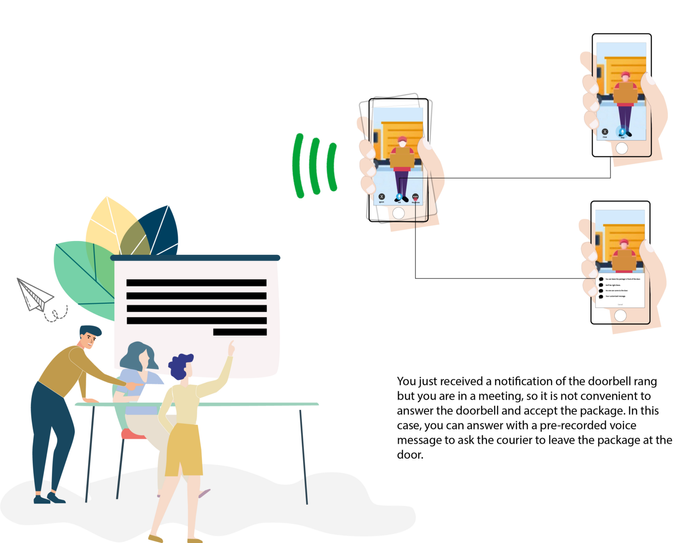
Redesign the Ring Smart Doorbell
-
Human-centered design approach
-
6-week design sprint
-
Tools: Figma, Sketch, Adobe Suite, LucidChart
Ring is an internet-connected doorbell incorporating a camera. The user can answer the door through a mobile app remotely with a live video call, as well as monitor the events. In this project, I conducted the human-centered design process to discover the pain points of the door answering and design opportunities to strengthen the sociality between the homeowner and visitors.
Contextual Research
As a 3-year user of the Ring doorbell, I first did observational research to better understand the landscape of the product and discover insights and opportunities. I also did secondary research by looking through online reviews for Ring and comparing Ring with other competitors such as Google Nest Hello.
User Research
From the context research, a high-level understanding was developed around the product ecosystem, and then I conducted user interviews to learn about below questions I had during the context research:
1. For people without a Ring, how are the general experience/pain points with the doorbell or answering the door?
2. What behavior/habit has changed before and after owning a smart doorbell?
3. For people with Ring, what do people like or dislike about this Ring doorbell?
4. What is their experience with Ring Neighborhood? Is it for security, fun, or both?
I conducted 8 rapid interviews each lasting 15min and an in-depth interview for an experienced user for 1hr. For detailed interview notes, please visit the slides here. The interview insights are synthesized below:

Insight Generation
I then made a list of HWM (How Might We) questions for each design opportunity area. As a frame of innovative thinking, a HWM question suggests that a solution is possible and can be answered in a variety of ways.
1. HMW makes it easier to explore historical events to find the one in the user’s interest.
2. HMW shows more insight in the notification summary.
3. HMW makes it easier to answer the smart doorbell in different scenarios (e.g. when the internet connection is slow).
4. HMW provides more context before/when the user answers the doorbell.
5. HMW makes package delivery easier in certain scenarios (e.g. knowing the package is delivered on time or making the delivery person feel better with his/her own experience)?
6. HMW consolidates the community with more data insight, security, and fun with Ring Neighborhood.
7. HMW makes users feel more connected with other users.
8. HMW integrates AI into the Ring to make it feel smarter, such as object recognition.
I organized opportunities from the above HMWs into a frame. The below opportunity framework describes how the potential design opportunities can be derived from the 6 groups of insights.

Design Concept Sketches
As a divergent exploration, I sketched around 80 design concepts for anything I could think of to solve the above HMW questions. They range from small changes on top of the existing design to solve user pain points, to complete renovation of the device to bring in new interactions between users and the system.
Design Iterations
The biggest pain point hurting the usability of Ring is to answer the doorbell in non-ideal situations (homeowner busy at work, slow internet, etc.), while it is also the innovation of the doorbell answering experience that brings more sociality and meaning in a closer neighborhood. In the next and final phase of prototyping, I chose to refine the ideas of doorbell answering experience between the homeowner and the system, as well as sociality between the homeowner and visitors.
I used storyboards to help illustrate the context of how the user will interact with new design concepts. The underlying stories clarify the key features to be prototyped.
I achieved high-fidelity prototypes from multiple iterations from early concept sketches. Some of the iterations are shown below.
-
Iterations of the flow for answering the doorbell with pre-recorded messages:

-
Iterations of the flow for answering the doorbell with pre-recorded messages:

-
Iterations of the flow for answering the doorbell with pre-recorded messages:

Final Wireframe

















